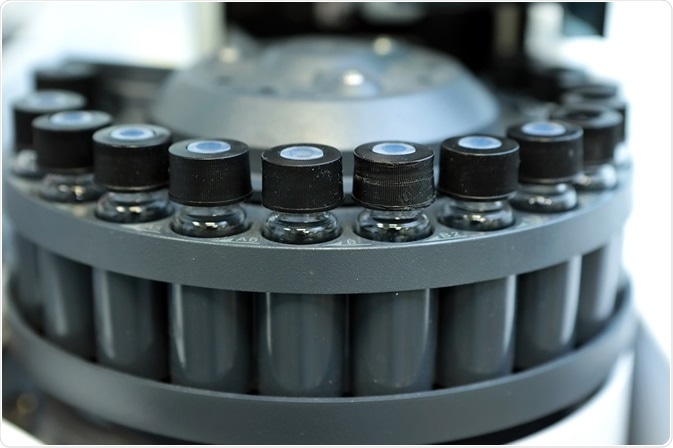Mass spectrometry (MS) is mainly involved in analysis of mass-to-charge ratio (m/z) and large quantity of ions traveling at high speed in vacuum. It is one of the most powerful tools used in investigation of the structure and composition of matter.

Credit: Cergios/ Shutterstock.com
Ionization and coupling are two different sub-disciplines in the field of mass spectrometry. Ambient ionization allows direct, high-throughput, surface study of native samples.
And for the study of a complex mixture, isolation techniques are coupled with the mass spectrometer to acquire a spectrum that is used for distinguishing the isolated product. A combination of these two disciplines leads to the development of comprehensive miniature analytical systems.
Ambient Ionization Techniques
Desorption electrospray ionization
Desorption electrospray ionization (DESI) involves charged droplets for ionization of analyte molecules in a sample. An electrospray with high DC voltage and sheath gas such as nitrogen is used to produce high velocity charged droplets that collide with the substances in the sample. This results in the formation of a thin solvent layer on the sample surface and generation of secondary micro-droplets that leave the surface.
In this process, dry ions of the analyte are produced in air and they are carried to the mass spectrometer for analysis. DESI MS image so produced is a two-dimensional representation of the distribution of an examined sample.
Low temperature plasma ionization
Low temperature plasma (LTP) probe is another method that involves active substances produced in low power plasma for removal and ionization of the analyte in crude samples. Low temperature plasma is formed by a dielectric barrier discharge.
Discharge gases, such as helium, argon, nitrogen or air, are allowed to pass through an alternating electric field that is generated by application of a high voltage alternating current between two electrodes with dielectric barrier material layers in between to inhibit the discharging of current. A device allows the extraction of plasma species through the discharge region by integrating the force of the gas flow and electric field, for testing the chemicals on the surface.
The process of analysis does not raise the temperature of the sample, nor does it cause any macroscopic damage to the sample.
Paper spray ionization
Paper spray ionization is a recent technique of producing ions from the sample on a paper substrate. This method is also used in various applications for faster analysis due to its ability for direct ion generation.
In the process of paper spray ionization, the sample is fed in a paper and added with a small quantity of methanol/water solvent comprising organic compounds, amino acids, peptides, and proteins. Then the paper is electrified to obtain spectra similar to electrospray ionization. The chemicals present in the surrounding surface of the sample are then collected and later examined.
Atmospheric pressure chemical ionization
Atmospheric pressure chemical ionization (APCI) is an ionization technique carried out using sources similar to that of electrospray ionization. In this method, the high DC voltage is accumulated on a needle that produces corona discharge at atmospheric conditions. This discharge generates hydronium ions or water clusters.
The sample is introduced into the discharge through a spray formed by a liquid and heated gas combination. This leads to volatilization of the sample and later formation of ions due to the proton transfer from the hydronium ions to the sample. Then the ions are extracted into the same vacuum opening that is used in the electrospray method.
Direct analysis in real time
Direct analysis in real time (DART) is a recent ambient ionization technique fostered to allow quick and complex studies without prior sample preparation. DART involves metastable gaseous atoms like helium or molecules that collides with a surface leading to desorption and ionization of the sample.
Coupled analytical techniques
Gas chromatography /Mass spectrometry
Gas chromatography mass spectrometry (GC/MS) is an analytical method that consists of a gas chromatograph (GC) and mass spectrometer (MS) coupled together for the analysis of complex chemical mixtures of relatively low molecular weight which include the processes such as isolation, classification and quantification.
Generally, the substance to be analyzed must be volatile and thermally stable enough. The compounds with functional groups require additional chemical alteration before the analysis to avoid adverse adsorption effects that could influence the quality of results.
Liquid chromatography/Mass spectrometry
Liquid chromatography–mass spectrometry (LC/MS) is also an analytical method in which the application of both high performance liquid chromatograph (HPLC) and mass spectrometer (MS) are coupled together for analysis of compounds that are thermally spontaneous with high polarity and with high molecular mass such as proteins.
The separation of compounds are carried out in LC/MS based on the relative interaction with the particles (stationary phase) and the solvent (mobile phase). The general ionization techniques involved in LC/MS are electrospray ionization and atmospheric pressure chemical ionization.
Further Reading